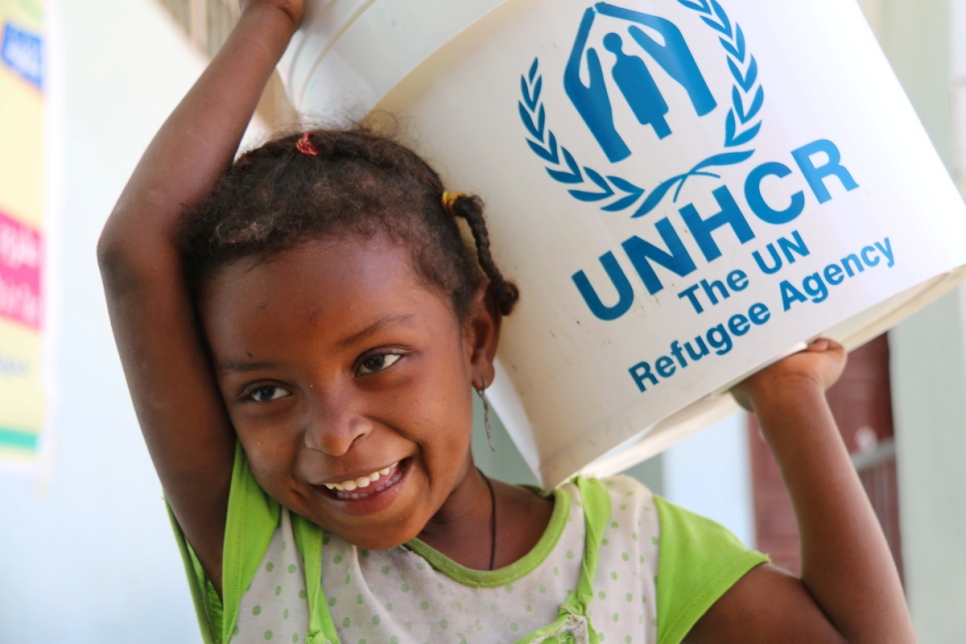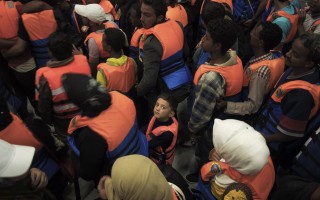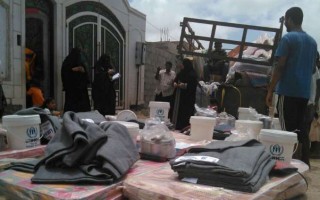
Firial (age 8) helping her father Ali collect goods during the aid distribution in Al Hagri school, Al Mudafar district, Taizz. © UNHCR/Mohammed Al Hasani
More than 125,000 displaced people in the embattled southern town of Taizz in Yemen have received emergency supplies as part of a new aid push, UNHCR said today.
The UN Refugee Agency said the latest aid distributions were part of an on-going humanitarian response since the conflict began in March 2015 and not linked to a ceasefire reached earlier this week.
However, UNHCR spokesperson Adrian Edwards told a press briefing in Geneva: “Access has often been difficult and UNHCR welcomes this week’s ceasefire … the opportunity to get help to people in need in hard-to-reach, conflict-affected areas is particularly important.
“We hope the ceasefire lasts and leads to peace talks.”
“We hope the ceasefire lasts and leads to resumed peace talks and more such opportunities for aid to get through,” he added.
He said UNHCR planned to reach more than 125,000 individuals under the current aid push. Already this month and prior to the ceasefire, UNHCR had reached some 12,309 people (in Al Hudaydah, Amanat Al Asimah, Amran, Hajjah, Sa’ada and Sana’a governorates).
“An additional 21 convoys are on the move or being prepared for Taizz as well as five other governorates – Ibb, Amanat Al Asimah, Amran, Hajjah and Al Hudaydah) governorates. These areas are host to 65 per cent – 1.427 million people – of Yemen’s 2.21 million conflict-displaced population,” Edwards detailed.
The aid UNHCR is delivering is non-food aid. Included in it are tarpaulins, sleeping mats, blankets, kitchen sets and buckets for hygiene and sanitation. Shelter repair kits will help about 25,760 people.
Much of this assistance had either been prepositioned in UNHCR’s warehouses in Sana’a and Al Hudaydah governorates or shipped to Al Hudaydah port through recent deliveries totalling 1,475 tons.
The latest aid push follows weeks of preparation for the movement of convoys.
UNHCR has been advocating with parties to the conflict for regular, sustained and unimpeded humanitarian access to those most in need.
Humanitarian operations in Yemen are still constrained by the conflict, which has left 21.2 million people (more than 80 per cent of the population) in need of help.
Much vital infrastructure has been destroyed and the economy devastated. Shelter has emerged as a key need for displaced Yemenis, along with food and drinking water.
“Most of the uprooted, some 62 per cent, are being accommodated by overstretched local communities while others stay in rented accommodation or in makeshift arrangements, including public or abandoned buildings and informal settlements, at risk of harm and with little or no protection,” Edwards added.
The devastating conflict in Yemen has left more than 2.2 million people internally displaced and forced some 180,500 people to flee to other countries in the region. There are also 278,034 registered refugees and asylum seekers in Yemen, mainly from Somalia and Ethiopia.





